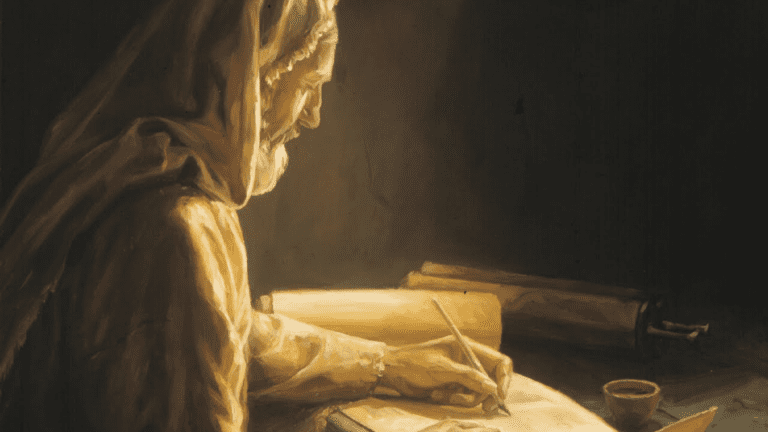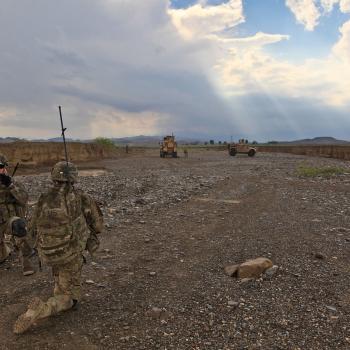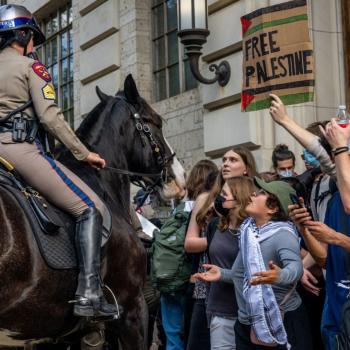
Note: this week’s reading is going to be difficult and have a little extra reading. Prepare for some extra time and extra contemplation.
Monday: Read Revelation 12:1-17; Eph 6:10-17
In Rev 11:1-13, I argued that we have reached the pinnacle of the story. The Scroll has been opened, eaten, and its contents revealed. God will bring about the redemption of the nations and the restoration of creation through the faithful, loving, and sacrificial lives of His people! Ta-da! The end!
There was, however, in the midst of the account of the Two Witnesses (11:1-13), a somewhat surprising note that “the Beast” will “make war” against the Two Witnesses and kill them (11:7). This raises some questions: such as, “What do you mean by, ‘The Beast?’, and ‘he makes war?’, and ‘kills them?’”
In a sense, answering these questions is the role of 12:1-14:5. Namely, to provide more detail about “the war” that results in the death of the Two Witnesses.
In 12:1-17, John puts this war into an historical context.
The key players in this chapter are:
Woman: likely the people of God: both the people of God before the coming of Christ and the people of God after the coming of Christ (note: 17)
Dragon: Satan (9).
Child: Jesus (5).
In terms of the narrative, 12:1-17 goes backward in time in order to provide a context for this “war” in the present.
Questions to ponder/discuss:
- Paul says in Eph 6:10-17: “Our battle is not against flesh and blood.”
- Rev 12:1-17 describes Satan as waging war against the people of God since the beginning. This, however, can be misunderstood. For example, some may wrongly conclude that all non-Christians are allies with Satan (the Dragon). This is not what the biblical story suggests. Satan is indeed our enemy, but the call of the Gospel and the kingdom—and the message of the book of Revelation in particular—is that we are called to me the means by which God makes Himself known to the nations.
- The enemy, in other words, is Satan. It is not people of other faiths. Nor is it people of other racial groups, nations, or political parties. Note that when we make people of the latter three designations, we might even be making Christians our enemies.
- Discuss what it might look like to love our neighbor even when they don’t agree with us. And discuss what it might look like to love them so that Christ may be made known to them through your love.
Tuesday: Read Revelation 13:1-10; Dan 7:2-8, 13-14, 17, 23-28
There is little doubt among scholars today that the biblical background for 13:1-8 is Daniel 7.
In Daniel 7, we learn of four Beasts that stand opposed to the kingdom of God. These Beast are in fact four kingdoms (Dan 7:17). These kingdoms will wage war against the people of God (Dan 7:21). In the end, they will be destroyed by the Son of Man. Then God will set up His kingdom and give it to the people of God (Dan 7:27).
Questions to ponder/discuss:
- It is critical for understanding the book of Revelation (and the NT; and even the OT) to recognize that the Bible views things through the lens of contrasting kingdoms: namely, the Kingdom of God and the kingdom(s) of the world. One of the key differences between these kingdoms is that Jesus’ kingdom—for which He is the king and we are/shall be kings/queens—does not rule the way the nations do. The nations rule through the use of force and brutality, and for the benefit of those in power and often at the expense of the masses—especially the poor and the marginalized.
- For John, and I would affirm, the rest of the authors of the biblical text, the kingdom of God, by way of contrast, rules by means of love. God’s kingdom, as exemplified by Jesus, manifests love by denying one’s own interests and even sacrificing self for the sake of the other. The cross is one of the best ways of contrasting the two kingdoms. For the kingdoms of the world, the cross is the ultimate embodiment of power. Anyone who objects to Roman rule, for example, was nailed to a cross. For the kingdom of God, the cross is also the ultimate embodiment of power. Of course, the cross was the very means by which God demonstrated His love for us. In the kingdom of God, in other words, God reigns through love and by sacrificing Himself for the sake of others.
- The contrast between how the kingdoms of the world do power and how power is done in the kingdom of God is precisely what Jesus was trying to explain to His disciples in Mark 10:42-45.
- In light of this, discuss what you think “take up your cross and follow Me” (Mark 8:34) means.
Wednesday: Read Revelation 13:1-10 (again)
In 13:1-18, John provides the details as to how the Dragon goes about waging his “war” against the people of God.
What we will learn is that the Dragon enlists the aid of two Beasts to do his work for him! Today’s Beast (13:1-8) comes from the sea (13:1) and represents imperial power.[1]
It is very important to recognize that the source of power behind the Beast is Satan (13:2; the Dragon).
Note that 13:1 (or 12:18—depending on your translation) sets the scene with “And the dragon stood on the sand of the seashore.” In 13:2, John adds, “And the dragon gave him [the Beast] his power and his throne and great authority.” In 13:4, John notes, “they worshiped the dragon because he gave his authority to the beast.”
For John, Rome was the present embodiment of the Beast. In 13:1-8, John describes a system in which Rome maintained its power and the oppression of the people by creating a state in which the masses were dependent on the Roman system for survival. This included the incorporation of religious ideology to justify their positions. The belief was that the gods placed the emperor in power. It was therefore an essential component of one’s religious duties to recognize his divine right to rule. In fact, appeasing the gods was critical to maintaining order and peace within the empire. This meant that for the masses, one’s civil and religious duties were intertwined and were a necessary component for ensuring the status quo within the empire.
Note: a detailed study of 13:1-8 and John’s use of Daniel 7 suggests that the Beast embodies all governments in history and not just Rome.
Questions to ponder/discuss:
- As we proceed through the book of Revelation, it is very important to constantly be reminded that John was writing to the churches. His concern was that some in the churches had compromised with the powers of the world and others were being tempted to compromise, in order to secure themselves a place in the Roman society and to avoid suffering.
- Discuss what things we might do/not do, or believe in our churches in order to avoid suffering.
Thursday: Read Revelation 13:11-14:5; Mark 4:3-25
It is worth being reminded again that the context for today’s reading begins in 12:1. As I noted, the section of 12:1-14:5 might best be understood in light of John’s effort to provide insights and details into the “war” against the Two Witnesses in 11:7.
In 12:1-17, John explains that this “war” is none other than the “war” that the Dragon (Satan) has been waging against the people of God since the beginning.
In 13:11-18, we learn that Satan also empowers a second Beast (who is called the “False Prophet” in 16:14). This Beast comes from the land and likely represents the religious side of the empire that worked to make sure everyone gave their allegiance to the empire.
In fact, if anyone does not give their allegiance to the empire, then they will be cut off from the economy: hence, “no one will be able to buy or to sell” (13:17).
Note that today’s reading includes 14:1-5. In 14:1-5, John again sees the 144,000 (see 7:1-8). This time they are following Christ (14:4) on the heavenly Mt Zion (14:1).
The reason why this is important is that in order to understand the account of the second Beast and the Mark of the Beast, we must recognize that the Mark of the Beast is contrasted with the Seal of God in 14:1-5.
That is, the Mark of the Beast clearly parodies the Seal of God on the 144,000. Note that both the Mark and the Seal are on the foreheads (13:16; 7:3); both are the name (13:17; 14:1; 22:4); and, whereas without the Mark of the Beast, one cannot “buy or sell” (13:17), the 144,000 are described as those who were “purchased” (14:3).
Questions to ponder/discuss:
- John most likely intends for us to understand the Mark of the Beast and the Seal of God are indicators of ownership. If so, then one of the questions that the book of Revelation raises is: “To whom do you give allegiance?”
- As for our understanding of the Beasts, we must keep in mind that the moniker “Beasts” is an important epitaph. In Genesis, humankind was to “rule over the “beasts” and “creeping things” (Gen 1:26-27). Instead, as the book of Revelation makes clear, the Beasts and the creeping things rule over the nations.
- As noted earlier, it is very important to keep in mind that John was writing to the churches. His concern was that many in the churches had compromised with the powers of the world in order to secure themselves a place in the Roman economy (they could work and earn a daily living) and in the social world around them.
- In the Parable of the Sower (Mark 4:3-25), Jesus explains that the seed sown on among the stones (rocks: Mark 4:16-17) represents those who bore no fruit because they were not willing to make Jesus known at the cost of suffering and persecution.[2] This parallels John’s account of the first Beast.
- In the Parable of the Sower (Mark 4:3-25), Jesus also explains that the thorns (4:18-19) represent those who bore no fruit because they were not willing to make Jesus known at the cost of surrendering comfort, power, pleasure, wealth, and security.[3] This parallels John’s account of the second Beast.
- In light of all this, meditate (alone or in a group) and ask Christ to make known to you how/when you might have failed to make Christ known (bear fruit) in order to avoid suffering or in order to maintain your comfort, power, pleasure, wealth, and security (note: you may not get an answer right away. But I exhort you to keep seeking the face of Christ with these questions).
Friday: Read Revelation Rev 14:6-20; Matt 6:19-34
Again it is critical to keep in mind that John is setting forth a narrative and it is important to recognize where we are in that narrative.
The main story of the book of Revelation was completed in 11:1-13. When God’s Two Witnesses—which represent all of the people of God—fulfill their ministry, then the nations will be brought to repentance (11:13; unfortunately, not everyone in the nations is saved).
In 12:1-14:5, John adds more details to the story. In 12:1-18, we learned that “the war” (11:7) against the people of God is none other than that which Satan has waged against the people of God from the beginning.
In 13:1-18, we learn that Satan wages this war against the people of God by empowering two Beasts. That is, Satan uses the powers of this world to lure God’s people to compromise with the world’s systems in order to be able to participate in the economy or alleviate one’s suffering.
Then in 14:1-5, John again saw the 144,000 who were following Christ in eternal glory!.
In 14:6-20, we have a description of the final judgment. In this section, there are seven beings: Six times John will refer to “another angel” (6, 8, 9, 15, 17, 18), and in the middle of them we meet “one like a son of man” (Jesus! 14).
The first three “another angels” all make a proclamation. The first three “another angels” (6-11) are concerned with the struggle between true and false worship.
The last three “another angels,” along with Jesus (the “One like a son of man”), introduce us to two harvests. In 14-16, there is an account of the grain harvest. And in 17-20, there is an account of a grape harvest. The key distinction between the two harvests is that the grain harvest is the harvest of the people of God, while the grape harvest is the harvest of the nations.
Questions to ponder/discuss:
- After the description of the first three “another angels,” John inserts an exhortation to the people of God. The exhortation begins with a reminder “Here is the perseverance of the saints” (12). This exhortation is followed by another: “Write, ‘Blessed are the dead who die in the Lord from now on!’ ‘Yes,’ says the Spirit, ‘so that they may rest from their labors, for their deeds follow with them’” (13). These two exhortations are intended to remind the churches that the call to maintain one’s witness for Jesus may well come at a cost.
- As we have noted in earlier studies, there are two important elements for Western Christians to consider: 1) we must pray for, support, encourage, and even resource our brothers and sisters in Christ in parts of the world today in which maintaining their Christian faith comes at a cost; 2) we must self-examine and be willing to ask why it is that we don’t experience the same struggles? Is it simply because we live in a free country? Or, could it be that we have compromised our faith without fully realizing it?
Our goal is to keep these posts free of charge. I do not intend to ever hide them behind a paywall. I can only do this if those of you who have been blessed by them and can afford to give ($5, $10, $25, or more/month) do so. You can give a tax-deductible contribution by following this link.
Please share this post and let others know about determinetruth.
If you wish to view this blog on your smartphone through the Determinetruth app simply download the “tithe.ly church” app on your smartphone and insert “determinetruth” as the church name you wish to follow. Once it is loaded, simply click on the “blog” icon and it will automatically load.
If you would like to have Rob speak at your church or organization in person or via Zoom, please let us know by filling out the contact info on the Contact me tab on this site.
He is currently completing a commentary on the book of Revelation titled, “Revelation: a Love Story” (Cascade Books, pending 2024).
[1] Of course, “imperial power” needs to be defined. Let’s keep it simple and note that it represents the powers of the world’s systems.
[2] See the devotional guide study of Mark 4.
[3] This, of course, is my paraphrase of Jesus’ words.













